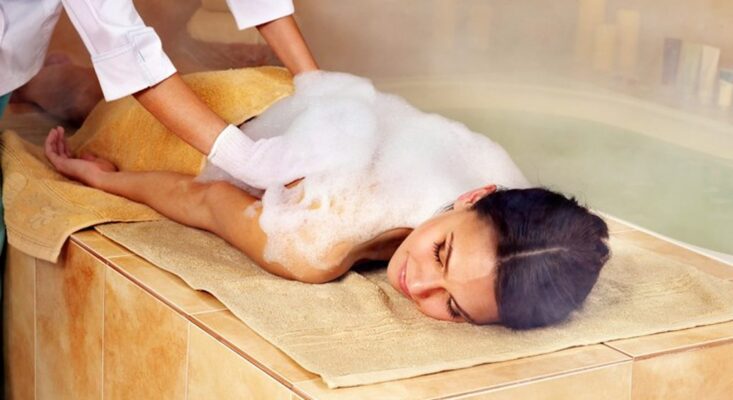- What is a Moroccan hammam?
- History of the Moroccan Hammam: Importance Cultural Significance, and Social Significance
- Preparing for the Hammam: What You Need
- Rewards of Immersing Yourself in a Moroccan Hammam Experience
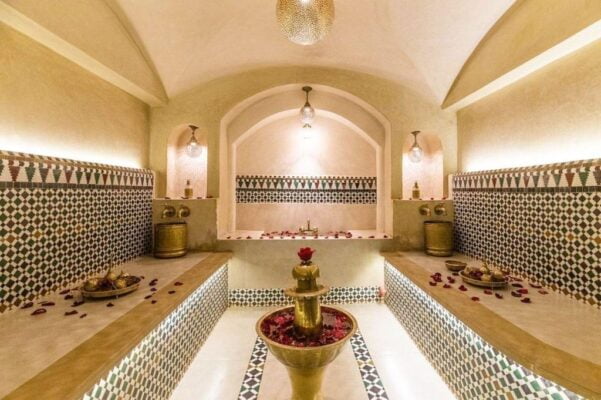
What is a Moroccan hammam?
Moroccan hammam are customary steam rooms of great cultural and social significance in Moroccan culture. The Moroccan hammam, which has its roots in Roman baths but is heavily influenced by Islamic customs, is a space for socializing, resting, and cleaning. Usually, it consists of many chambers: a warm room for exfoliating and cleaning, a cold room for rest, and a hot steam room. Using a kessa glove and black soap, guests in a Moroccan hammam exfoliate their skin to get rid of pollutants and dead skin cells. The hammam’s heat and steam aid in relaxation, bodily detoxification, and pore opening.Beyond physical purification, the hammam serves as a gathering place for individuals from many backgrounds to engage in conversation, relax, and reinforce communal ties. Because of their nourishing and aromatic qualities, a number of traditional products, like rose water, ghassoul clay, and argan oil, are frequently used in the hammam experience. The Moroccan hammam, valued for its healing properties and capacity to promote social bonds, is an essential component of Moroccan culture, whether it is found in private or public baths.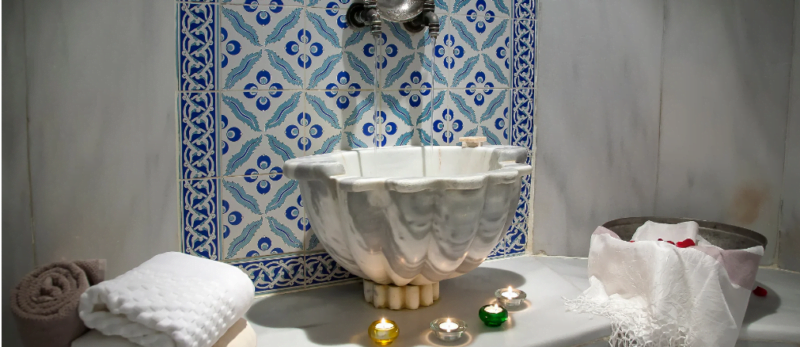
History of the Moroccan Hammam: Importance Cultural Significance, and Social Significance
The Moroccan hammam, a centuries-old tradition, has roots in ancient Roman baths and Islamic customs. Early Islam prioritized cleanliness and hygiene, making communal bathing a daily ritual. Hammams were used for physical purification, social interaction, and business. Over time, they evolved into architectural wonders, offering essential services and symbolizing the luxury and refinement of the ruling class. Today, Moroccan hammams continue to evolve and serve diverse communities.The hammam, a traditional Moroccan bathing facility, holds significant cultural and social significance. It represents Islamic teachings of modesty, self-care, and purity and is considered a sacred area for purging pollutants and cleansing bodies. The hammam is a social hub where people from all walks of life congregate, promoting community and belonging. Despite private baths becoming more common, Moroccan society values the hammam as a sacred ritual.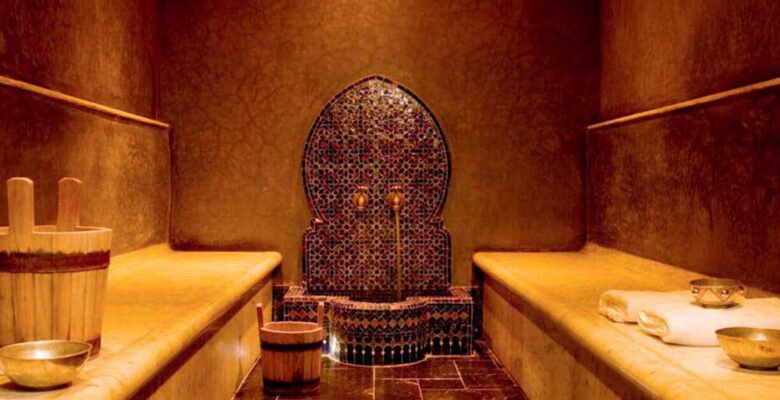
Preparing for the Hammam: What You Need
step 1: Choosing the Right HammamBefore embarking on your hammam experience, it’s essential to carefully select the right hammam facility. Consideration should be given to factors such as location, reputation, and services offered. Researching online reviews or seeking recommendations from locals can provide valuable insights into the quality and cleanliness of different hammams. Additionally, assessing the ambiance and atmosphere of the hammam is crucial for ensuring a relaxing and enjoyable experience. Whether you prefer a traditional, no-frills establishment or a more luxurious spa setting, choosing a hammam that aligns with your preferences and expectations is key to maximizing your experience.step 2: Tips Before Departure Here are some helpful pointers to remember before you start using a hammam:- Make a reservation in advance. Especially during the peak travel seasons, some hammams might get extremely busy. To guarantee your seat, make sure to schedule your session in advance.
- Separate or Mixed Hours: Different hammams have varying policies regarding separate or mixed-gender hours. Some offer separate hours for men and women, while others allow both genders to bathe together during certain times. Choose the option that aligns with your preferences and comfort level.
- Dress appropriately: Bring along a loose-fitting bikini or swimsuit to wear in the hammam’s bathing areas. While some establishments may provide disposable clothing, it’s recommended that you bring your own for maximum comfort and hygiene.
- Hydration: Drinking plenty of water before and after your hammam session is essential to staying hydrated, especially considering the heat and steam of the bathhouse environment.
- Avoid Heavy Eating: To ensure a more comfortable experience, refrain from consuming heavy meals before your visit to the hammam. Opt for a lighter fare to avoid any potential discomfort during your session.
- Relax: Arriving early allows you to fully immerse yourself in the hammam’s tranquil atmosphere without feeling rushed. Take advantage of the opportunity to unwind and relax before your session begins, enhancing the overall enjoyment of your experience.
- Swimsuit: Make sure it fits properly and is pleasant to wear in the bathing regions.
- Towel: Bring a towel so you can cover yourself if necessary and dry yourself after your bath.
- Flip-flops: It is advised to wear flip-flops or shower shoes when strolling through the hammam’s damp sections.
- Personal Hygiene Supplies: Although some hammas include shampoo, shower gel, and moisturizer, you are welcome to bring your own.
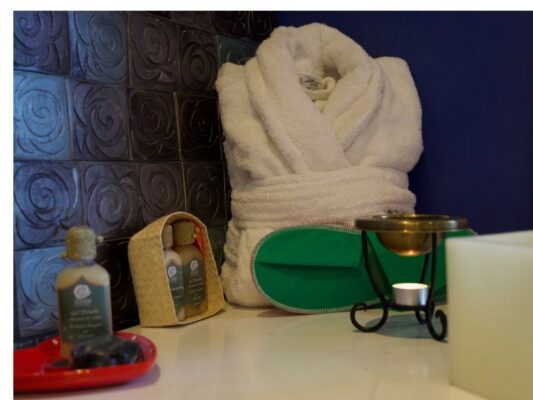 Step 4 : Products and Traditional Ingredients
Step 4 : Products and Traditional IngredientsMoroccan Hammam Skin and Beauty Treatments
- Black Soap (savon beldi): The key component of the Moroccan hammam is savon beldi, the famous black soap. It works for all skin types and has antibacterial qualities. Traditionally, black olive paste, virgin black olive oil, and organic components are used. Its goal is to thoroughly clean, remove dead skin, and purify the skin of dirt. The skin will feel smooth and soft after using this soap to give it a good deep scrub. If you leave the work to an attendant, don’t be scared to scrub hard, and be prepared for a thorough scrub. Made from macerated black olives and olive oil, Because it is a superb moisturizer that is rich in vitamin E, it may be applied to the entire body, including the face. Savon Beldi is a self-contained holistic body therapy. It aids in the treatment of skin disorders like psoriasis, eczema, and acne, in addition to strengthening and renewing skin cells.
- Rhassoul, or ghassoul clay, is a clay with several advantages for skin health that comes from Morocco’s Atlas Mountains. In addition to thoroughly cleaning the pores and purifying them, it detoxifies the skin. Potassium and magnesium are abundant in ghassoul. Dead skin cells are removed from the skin by the clay’s texture, which also leaves the skin feeling clean and smooth. Ghassoul can be wrapped all over the body or used as a mask. Because of its inherent astringent qualities, it also helps with eczema, psoriasis, and acne. The minerals in the clay are also good for the health of your hair. It can be applied as a shampoo to detangle and condition hair, leaving it lustrous, smooth, and soft.
- Argan oil: Often referred to as the “liquid gold of Morocco,” The indigenous Amazigh/Berber people of Morocco have long utilized argan oil, a centuries-old beauty remedy, to rejuvenate their skin and hair. The nuts of the argan tree, which is indigenous to Morocco, are used to extract oil. This amber-colored oil has gained the nickname “liquid gold” due to its therapeutic properties. Rich in omega fatty acids and vitamins A and E, argan oil has anti-inflammatory and antioxidant properties that support the health of skin tissue. Argan oil massages are available at several hammas for an additional cost, and they are well worth it. It not only aids in muscle relaxation but also thoroughly nourishes the skin from head to toe.
- Floral Waters: Moroccan skincare products frequently contain floral waters, such as orange blossom water and rose water. They are prized for their calming, toning, and revitalizing qualities and are made by distilling orange blossom or rose petals. These flower fluids are frequently used as lotion and face mask ingredients, as well as skin tonics.
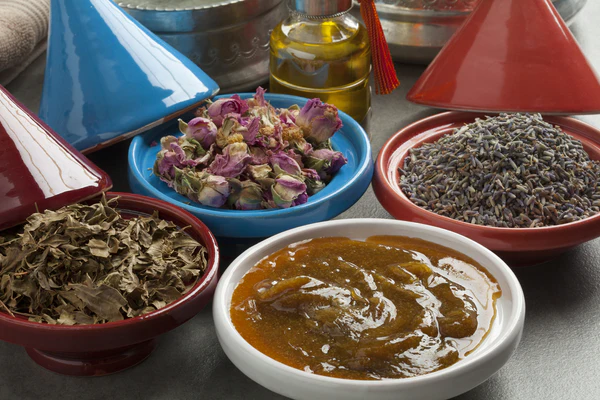 Step 5 : Using Henna for HairUsing henna for hair treatment is a popular practice in Moroccan hammams, known for its conditioning and coloring properties. Before applying henna to your hair, it’s essential to prepare the mixture according to the instructions provided. Typically, henna powder is mixed with water or other liquids to form a thick paste, which is then applied to the hair and left to set for a specified period. The duration of the treatment may vary depending on the desired color intensity and conditioning effects. After rinsing out the henna paste, the hair is left with a vibrant color and enhanced shine, thanks to the natural dye and conditioning properties of henna.
Step 5 : Using Henna for HairUsing henna for hair treatment is a popular practice in Moroccan hammams, known for its conditioning and coloring properties. Before applying henna to your hair, it’s essential to prepare the mixture according to the instructions provided. Typically, henna powder is mixed with water or other liquids to form a thick paste, which is then applied to the hair and left to set for a specified period. The duration of the treatment may vary depending on the desired color intensity and conditioning effects. After rinsing out the henna paste, the hair is left with a vibrant color and enhanced shine, thanks to the natural dye and conditioning properties of henna.- preparation: make the henna paste. To make a thick paste, combine henna powder with warm water or other liquids, such as lemon juice or herbal tea. To let the dye come out, let the paste remain for a few hours.
- Sectioning: Divide your hair into sections that are easier to handle. To avoid staining your hands, put on gloves.
- Application: Distribute the henna paste evenly throughout each region of your hair, beginning at the roots and working your way down to the ends, using a brush or your hands. Ensure that every thread is completely saturated.
- Wrapping: To retain the heat and stop it from dripping, pile your henna-coated hair atop your head and cover it with a shower cap or plastic wrap.
- Waiting: For a richer color, let the henna paste sit on your hair for at least one to two hours. To improve the dye release process and retain heat, you can place a towel over your head.
- Rinsing: Use warm water to rinse the henna from your hair until it runs clear after the proper amount of time has elapsed. Conditioner can be used to facilitate washing.
- Drying: Use a gentle blow dryer or let your hair air dry. To give the color time to set, wait at least 24 to 48 hours before shampooing your hair.
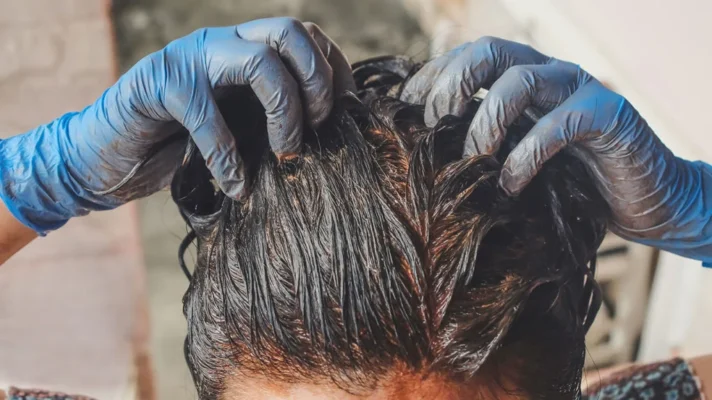 Step 6 : Using Henna for Body In addition to hair treatment, henna is also used for body decoration and skincare in Moroccan hammams. Applying henna paste to the skin creates intricate designs known as “mehndi,” which adorn the body with temporary tattoos. Before applying henna to the skin, it’s essential to cleanse and exfoliate to ensure optimal adherence and longevity of the design. Once the henna paste is applied, it is left to dry for several hours before being gently removed, revealing the intricate patterns underneath. The resulting henna tattoos can last for up to two weeks, serving as a beautiful and meaningful form of self-expression and adornment.
Step 6 : Using Henna for Body In addition to hair treatment, henna is also used for body decoration and skincare in Moroccan hammams. Applying henna paste to the skin creates intricate designs known as “mehndi,” which adorn the body with temporary tattoos. Before applying henna to the skin, it’s essential to cleanse and exfoliate to ensure optimal adherence and longevity of the design. Once the henna paste is applied, it is left to dry for several hours before being gently removed, revealing the intricate patterns underneath. The resulting henna tattoos can last for up to two weeks, serving as a beautiful and meaningful form of self-expression and adornment.- Mixing: To make the henna paste, combine the henna powder with either water or lemon juice until a thick, smooth consistency is achieved. To release the coloring, let the paste settle for a few hours.
- Design: Choose the layout you wish to use, and if needed, practice it on paper. Apply the henna paste to your skin using a cone or an applicator with a fine tip to create elaborate designs.
- Drying: Give the henna paste on your skin a full day or two to dry entirely. While it dries, try not to smear the design.
- Sealing: After the henna paste dries, you can cover the dried henna with a mixture of sugar and lemon juice to seal the design. This improves the henna paste’s ability to stick to the skin and enhances the color.
- Waiting: To allow the dye to stain your skin, let the henna paste on for a few hours or overnight.
- Removal: Using a tissue or cotton ball, carefully scrape off the dried henna paste. To allow the color to become more intense, refrain from using water on the area for at least 12 hours.
- Maintenance: To keep your henna pattern looking great for longer, don’t scrub the area and apply moisturizer frequently to keep the skin hydrated.
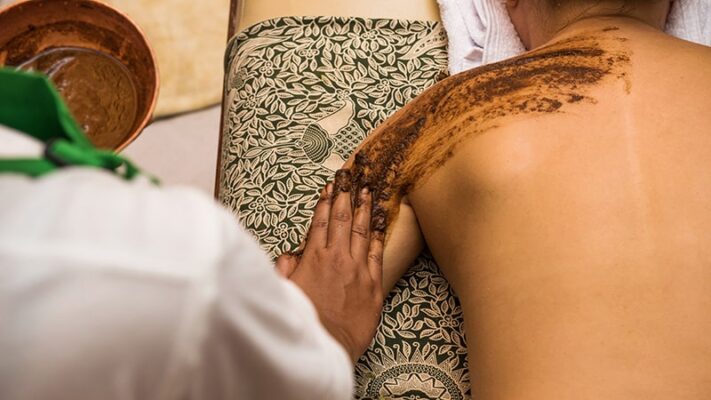 step 7: Massage and Relaxation TechniquesMassage and relaxation techniques play a vital role in enhancing the hammam experience, promoting stress relief and overall well-being. After the steam bath, many hammams offer massage services to help relax tense muscles and promote circulation. Traditional Moroccan massages often incorporate techniques such as kneading, stretching, and pressure point stimulation to release tension and promote relaxation. Additionally, hammams may offer other relaxation amenities, such as hot stone therapy, aromatherapy, or herbal steam rooms, to further enhance the therapeutic benefits of the experience. By incorporating massage and relaxation techniques into your hammam session, you can leave feeling rejuvenated, refreshed, and renewed.Types of Massages Tailored:
step 7: Massage and Relaxation TechniquesMassage and relaxation techniques play a vital role in enhancing the hammam experience, promoting stress relief and overall well-being. After the steam bath, many hammams offer massage services to help relax tense muscles and promote circulation. Traditional Moroccan massages often incorporate techniques such as kneading, stretching, and pressure point stimulation to release tension and promote relaxation. Additionally, hammams may offer other relaxation amenities, such as hot stone therapy, aromatherapy, or herbal steam rooms, to further enhance the therapeutic benefits of the experience. By incorporating massage and relaxation techniques into your hammam session, you can leave feeling rejuvenated, refreshed, and renewed.Types of Massages Tailored:- Prenatal Massage: Specifically designed for expectant mothers, prenatal massage focuses on relieving the discomforts associated with pregnancy, such as back pain, swollen ankles, and sciatic nerve pain.
- Hot Stone Massage: Incorporating heated stones, this luxurious massage soothes tense muscles and promotes relaxation, making it an ideal choice for women seeking deep relaxation and stress relief.
- Aromatherapy Massage: With the use of essential oils, aromatherapy massage offers women a sensory experience that not only relaxes the body but also uplifts the mood and balances emotions.
- Scalp Massage: Targeting tension in the head, neck, and scalp, this massage technique helps alleviate headaches, reduce stress, and promote healthy hair growth, catering to women looking for holistic relaxation.
- Reflexology: By applying pressure to specific points on the feet, reflexology stimulates the body’s natural healing processes, providing women with overall relaxation and well-being.
Benefits for blood circulation and muscle relaxation:
- Improved Blood Circulation: Massages enhance circulation by stimulating blood flow to muscles and tissues, aiding in reducing inflammation and promoting healing.
- Muscle Relaxation: Massage techniques help release muscle tension by breaking up adhesions and releasing tension knots, allowing muscles to relax and unwind.
- Deep Breathing: Therapists often encourage clients to practice deep and mindful breathing during the massage to promote relaxation and reduce stress.
- Guided Meditation: Some massages include guided meditation techniques to help clients mentally relax and connect with their inner state of calm and tranquility.
- Soothing Music: Gentle and soothing music can be used in the background to create a relaxing atmosphere and promote deep mental relaxation.
Benefits of Spending time in a Moroccan hammam
Spending time in a Moroccan hammam offers numerous benefits for both physical and mental well-being. Here are some advantages:- Deep Cleansing: The steam and heat in the hammam help to open up pores and cleanse the skin thoroughly. This deep cleansing can remove impurities, dirt, and dead skin cells, leaving the skin feeling refreshed and rejuvenated.
- Exfoliation: The use of traditional products like black soap and ghassoul clay in the hammam helps to exfoliate the skin, promoting cell turnover and revealing smoother, softer skin.
- Detoxification: The combination of steam, heat, and natural ingredients aids in detoxifying the body by stimulating circulation and promoting the elimination of toxins through sweat. This detoxification process can leave you feeling revitalized and energized.
- Relaxation and Stress Relief: The tranquil ambiance of the hammam, coupled with massage and relaxation techniques, provides a sanctuary for relaxation and stress relief. The heat and steam help to relax muscles and alleviate tension, promoting a sense of calm and well-being.
- Improved Circulation: The heat from the steam bath helps to dilate blood vessels and increase blood flow, which can improve circulation throughout the body. Better circulation can contribute to overall health and vitality.
- Skin Hydration: While the steam and heat help to open pores and cleanse the skin, they also promote hydration by allowing moisture to penetrate more deeply. This can result in softer, more hydrated skin, especially when followed by the application of moisturizing products like argan oil.
- Respiratory Benefits: Inhaling steam can help open up airways and improve respiratory function. This can be particularly beneficial for individuals with respiratory conditions like asthma or allergies.
- Cultural Experience: Beyond the physical benefits, spending time in a Moroccan hammam offers a cultural experience that allows you to connect with Moroccan traditions and rituals. It provides insight into Moroccan lifestyles and customs, enriching your overall travel experience.
